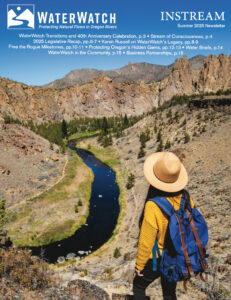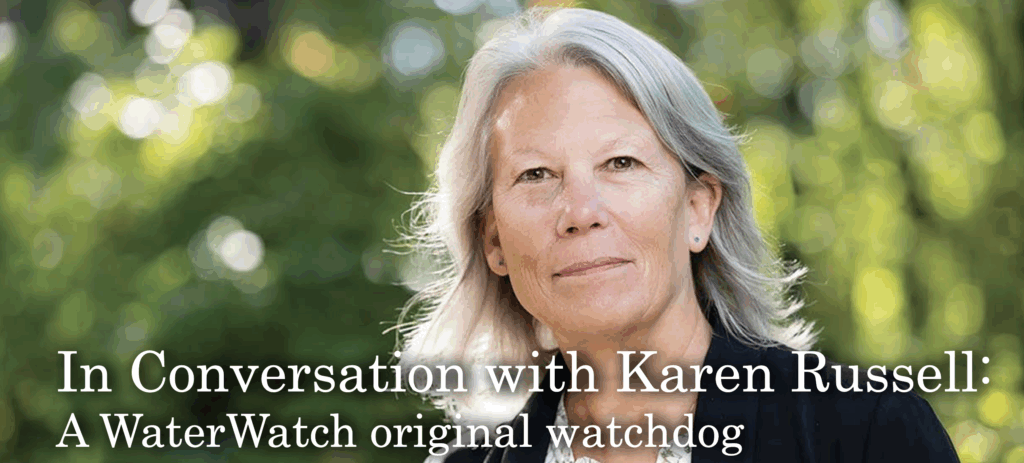As part of WaterWatch’s 40th anniversary, we’re featuring articles in Instream and at WaterWatch.org that highlight our work and success over the last four decades, and profiling some of the people who played key roles in building WaterWatch’s legacy.
By Tommy Hough
WaterWatch staff, board, and alumni often offer unprompted credit to Karen Russell for sharpening the organization’s policy growth and direction.
An adjunct professor at Lewis and Clark Law School and College in Portland, Karen served as senior staff attorney and water policy advocate at WaterWatch from 1990 to 2006, including a year as interim executive director in 2003. During her time at WaterWatch, Karen represented the organization in a variety of legislative, administrative, and court proceedings and forums.
“I graduated from the University of Washington, and then spent two years in New England working for two different environmental nonprofits,” said Karen. “It was there I got to see nonprofit lawyers in action, and that experience made me even more interested in pursuing law. So I ended up coming back to the Pacific Northwest to attend Lewis and Clark Law School.”
“I did a little work with Earthjustice when they were still the Sierra Club Legal Defense Fund, clerked for a summer at Bricklin and Gendler in Seattle, and clerked another summer with the Northwest Environmental Defense Center at Lewis and Clark. At the end of my third year of law school I applied for an administrative position with WaterWatch of Oregon, and interviewed with Bob Stacy and Ned Dunkrack, who were then on the WaterWatch board. Tom and Audrey Simmons were there, of course, as was Bob Hunter, as the founders of WaterWatch.”
Karen reflected on how environmental nonprofits like WaterWatch were, at the time, evolving in terms of mission and focus. “Back then conservation jobs were harder to come by, but people realized it was important to have scrappy nonprofits willing to litigate. I went straight from law school to WaterWatch, and in no time was working for the organization in the legislature and helping with administrative appeals and litigation. Tom and Audrey’s focus was primarily on legislative and big picture policy change, and some of what I brought to WaterWatch was a willingness to review all the public notices and flag bad things when they came up.”
It was here Karen began to carve out a defined role for herself at WaterWatch. “We were willing to file a protest on every single application that came through that didn’t have a measurement or reporting requirement to force the state to deal with water issues,” she said. “I would go through every single public notice, and my role was to be in the weeds as needed in this evolving powerhouse with Tom and Audrey, Bob, and our lobbyist Doug Myers. Where I could make the greatest difference was in these individual permitting decisions in some of the rule rankings. It was a little more nitty-gritty.”
Some cases took on a life of their own from unexpected directions, including WaterWatch’s successful case against Boeing, which came about after the aerospace giant leased property near Boardman in Morrow County for a rocket-testing center, but instead sublet the land to tenants who began to develop it for cattle operations that would use 50,000 acre-feet of Columbia River water per year. Most of that water was drawn during warm weather months, when salmon are most stressed by low flows and high water temperatures.
“At first, the Boeing case was a bit of a stretch,” said Karen. “Normally our involvement would be strictly from the water rights angle, so I had to get permission to go outside the box to leverage the kind of pressure we needed. We applied multiple legal pressure points, including filing a listing petition under the state Endangered Species Act for the Washington Ground Squirrel to protect the threatened upland habitat, and a Clean Water Act case over the proposed expansion of water withdrawal facilities for the project. These actions, along with our water right appeals, created the pressure needed to get state agencies to clamp down on the project.”
Another case initially flagged by Karen early in her tenure took 15 years to reach a settlement. “On the coast, the Coos Bay-North Bend Water Board (CBNB) was sitting on a number of water rights they weren’t using,” she said. “They decided to apply for even more water, this time from Tenmile Creek, located to the north of Coos Bay. The Oregon Department of Fish and Wildlife was getting ready to file an application for an instream water right for the creek, and CBNB wanted to lock up a relatively large amount of water for its future use before the ODFW application was filed. CBNB was essentially gaming the system to get a more senior priority date than the instream water right application, even though CBNB had absolutely no need for that water. The CBNB application raised important policy concerns around the historic practice of municipalities filing water right applications to secure more senior priority dates, and then sit on the water until they were ready to develop or sell it.”
“WaterWatch was represented in the case by Brian Posewitz, who at the time was with the Portland lawfirm Tonkon Torp. Brian filed an appeal of CBNB’s application, and argued the statute very clearly limited new water use permits to water uses that would be developed within five years. The municipalities and state defended the state’s historic practice of issuing new water use permits even when, as in the case of CBNB, development wouldn’t begin, much less be completed, within the statutory time period. We argued that’s not what was in the statute, and the court agreed with us. This led to a legislative battle over what the policy should be with regard to municipal water development in the state. No one was willing to have that policy discussion until WaterWatch was successful in court.”
When asked to reflect on WaterWatch’s 40th anniversary, Karen had plenty of praise. “It’s amazing to think about what it was when I was in the office with Tom and Audrey and Bob, all running their tails off doing this great policy work, and how it’s matured into this organization that has managed changes in staffing, and stayed strong and true to its mission. A lot of organizations don’t necessarily do that, and that’s one of the things that makes WaterWatch unique. Our staff stay. Our board members stay. People remain committed to the cause.”
“It’s also exciting to see how more people understand water issues in the state than they used to, in part because they’ve been educated by WaterWatch’s work and remain excited about its mission. They care about our rivers, and are committed to this wonky thing called water law. Even the state is now recognizing water is limited, and more and more people recognize and acknowledge that.”
This article originally appeared in the summer 2025 issue of WaterWatch of Oregon’s Instream newsletter.


